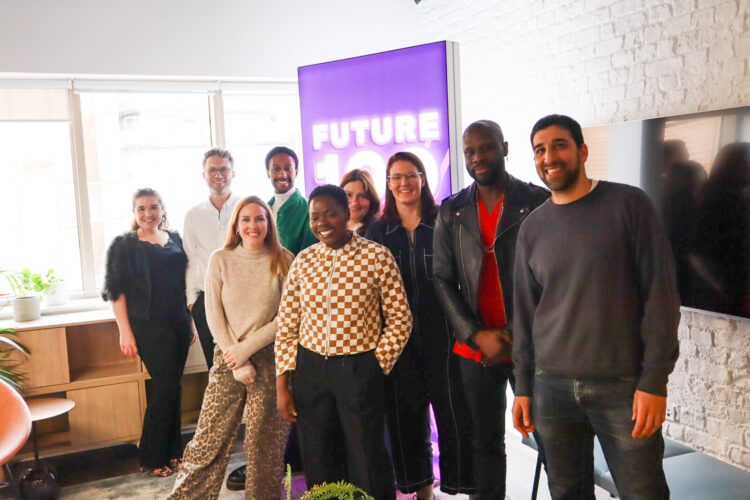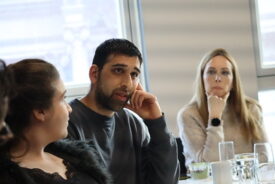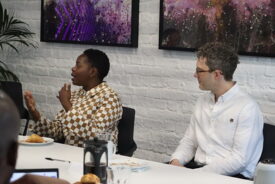Future 100: Working with data and AI requires balanced, human-centric approach


Data has undeniably transformed the way the media and advertising industry operates, but working with data effectively requires balance.
This means maintaining a healthy balance between data-driven decision-making and human creativity, and balancing the right performance metrics to keep both the chief marketing officer and chief financial officer happy.
The theme of balance was central to the discussion at a recent Future 100 Club roundtable event, in which 10 of the industry’s brightest minds came together to explore the role of data in modern media and advertising.
Despite their different roles, the group agreed on many of the key issues.
Data-driven decision-making vs human creativity
Data can enhance the creative process and allow us to produce more effective campaigns if used appropriately. But we may be in danger of becoming over-reliant on data — something that could harm the creativity that allows people to produce their best work.
“Data is useful because it gives a level of objectivity,” according to Sumran Kaul, client lead at Brand Metrics. “It’s hard to measure creativity, which is very subjective, whereas everyone can understand a statistic and so data gives us a common language.
“But then there’s a tendency to place too much value on it, because it fits into dashboards and you can send it to a CFO — and it’s hard to do that with cool campaigns. So we end up looking for ways to quantify every aspect of creativity, but then it ends up being led by data.”
Amanda Woodley, head of clients at Ipsos, also highlighted the concern of a data focus stifling a creative team’s work. But there must be a balance, otherwise that creative team’s hard work may end up going to waste anyway.
“From a creative effectiveness perspective, you can have this beautiful TV ad, but if the logo only comes in the last five seconds, it’s not as effective as it should be because the data tells us people have already switched off by then,” she explained.
“I don’t want to stifle creativity, but you also have to ensure your teams are not working in silos, from creative design to planning through to execution. I understand data is boring and creative people just want to make beautiful ads, but if that ad doesn’t answer the KPIs of the campaign, the campaign is going to fail.”
Emily Alcorn, chief effectiveness officer at Talon, brought the issue of balance into the conversation in a different way, warning against becoming too reliant on data.
Data is valuable, but so is human creativity and taste. In other words, data shouldn’t be taken at face value without applying critical thinking, context or good judgement, she argued.
Samantha Eales, head of commercial audience data at Mail Metro Media, used an example of when data can provide insights that simply aren’t right for a particular campaign.
She said: “I often have to ask: does it follow the human common-sense test?
“For instance, a beauty campaign for a particular brand. Objectively, the data might say that the number one contextual segment we should target could be Charlotte Crosby, for example. But maybe that doesn’t suit the brand itself; maybe they’re actually a premium brand.”
“And so, although the data is saying one thing, I need to use my judgement to ignore that and make decisions for the client that are best for them. So my job is always to put a human common-sense test on what that data is telling me.”
Alcorn agreed: “While you do need the data and frameworks, it still needs to be underpinned by human knowledge and experience to bring that to life. Otherwise everything’s going to be forced into models in a very unifying, sterile way when actually we’ll always need that human intuition and knowledge.”

“That’s where the importance of real creativity comes back in,” suggested Eleisha May, client strategy director at Blis. “We must maintain human creativity and not let data stifle that. As we all use the same tools, everything starts to look and feel the same.”
“But when you see an ad campaign that’s really different and really creative, you are really engaged by it. Everybody looks forward to the John Lewis Christmas ad. There are such high expectations on that, because it’s beautiful and creative, and those ads perform phenomenally.
“So when you maintain that creativity and authenticity, it works really well.”
Use data to better reach and resonate with audiences
Of course, when used in intelligent, innovative ways, data can enable more creative campaigns.
“From our perspective, data has made us more creative,” said Alcorn. “For example, we used data to create a campaign for a porridge brand during winter, where the ad would only appear when the temperature dropped below 11 degrees — and that had massive engagement.”
However, Alcorn did echo the group’s caution. She added: “I can see how we might get to a point where we become slightly over-reliant on data like that. But I do feel like it’s helped fuel our creativity.”
Eales noted: “Audience data is really good for driving creativity, by understanding what resonated with your audience and making different creatives for different audiences, or using analytics to understand what time of day to advertise, for example.”
Focus on the right strategic metrics
A big debate during the roundtable was which metrics to focus on when measuring and reporting on performance.
Citing the adage of “If a tree falls in the woods with no one around to witness it, does it really make a sound?”, John Duku, client director at Wavemaker, demonstrated that data is critical in understanding how successful campaigns have been.
“It’s super important to have data in that sense of having a way to appraise whether our work is actually effective,” he pointed out.

That said, it was generally agreed that vanity metrics, such as “likes” on social media, aren’t valuable in the majority of cases and shouldn’t be used to determine the success of campaigns.
The group suggested that the key is to be very clear on the strategic objective of the project first, before determining the best metrics to judge the quality or relevance of the results.
To demonstrate that, Duku used an example of how many government campaigns intend to drive behaviour change — entirely different from how most corporate ad campaigns are measured.
“A lot of what I do with the government is about behaviour change,” he explained. “We can achieve vanity metrics for our government clients, but if the audience doesn’t stop smoking, or drivers keep speeding, then my campaign hasn’t been a success.”
Woodley supported that point, adding: “It’s important to understand what the bigger picture is and move into a broader view on campaigns, like what’s their overall objective? What are they actually trying to achieve?”
One thing was clear from the participants. There is a variety of approaches to measuring and reporting on media and ad campaigns, and different people have different priorities.
The industry would benefit from more consistent, shared standard to help everyone make better decisions with the data they’re collecting.
Communicate data-driven findings simply
When it comes to effectively communicating data to stakeholders, Adesuwa Osewa, associate director at Word on the Curb, acknowledged: “We have to admit data is boring and only interesting to people who understand it.
“We’re the data experts, so our job is to be storytellers and communicate the data in a way that translates, and make sure it really lands for our clients who don’t understand it.”

One way is to make it entertaining and therefore more relatable.
Osewa continued: “We’ve created an ‘edutainment’ model, which combines education and entertainment to make data more exciting. So when we’re doing focus groups and creative workshops, it makes the conversations more fun.”
Woodley added: “I would say we’re guilty of over-complicating a lot of things. When it comes to data, we need to simplify a lot of what we do, based on what the actual person we’re working with needs or is trying to achieve.”
Maintain integrity and honesty
Building on that topic, another key takeaway was that clear, human storytelling is important for getting maximum value from data.
Timur Cetin, product marketing lead at Samsung Ads, said: “It’s super important to consider the fact that the data, by itself, is hard for many people to digest.”
A client of Cetin pointed out that not only is data becoming more complex and difficult to understand, but stakeholders often have less time to digest it these days.
“Our clients have less time to read and understand data now, whereas maybe 10 years ago they were more interested in it,” he said. “Now they just want to know why it’s relevant and how it’s actionable.”
The sheer volume of data and information involved in modern business is another factor that needs to be considered. Therefore, knowing how to showcase only the most relevant and useful data is another vital skill for the industry.
“We’re swimming in metrics and data paralyses us into indecision,” Woodley observed. “We need to take things back to basics, making sure that only the right information is in front of the right person, because otherwise it’s overwhelming.”
But perhaps the most important reminder on this topic was that data is objective, while people aren’t. When crafting stories to communicate findings or measurements, it’s vital to strive to be as honest and as objective as possible.
“There’s so much data out there, you can basically tell any story you want,” warned Kaul.
The key is to maintain transparency, integrity and clarity to ensure that the right data is being presented in a useful and accurate way.
Tashan Nicholas, director at Magic Numbers, said: “We must treat data in a truthful and authentic way. As someone who measures data independently, I see a lot of self-selection of evidence in the industry and perhaps that isn’t necessarily leading to the best strategic decision-making.”
Returning to the overarching theme of balance in every facet of data, Nicholas added: “For our clients, our sole objective is to make their business grow. That has to come from a place of truth, of course, but it also needs to be communicated in a way that’s going to lead to action.”
Other key considerations
It’s almost impossible to have a conversation about digital media without mentioning AI.
With AI removing a lot of the “doing” from people’s roles, the resulting negative impact on data literacy as well as creative thinking and general common sense was a concern for the group.
“I do worry about the future, when it comes to data literacy and AI, for the young talent coming in,” Eales said. “They just type something into our AI and don’t learn, and don’t know how to tell that story.”
Nicholas concluded: “Experts believe humans must also continue to learn how to think and judge, and maintain their human ability to be creative, as well as understanding technical skills like data, because of that need for humans in the loop.”
Alcorn added: “AI and data are making people more sterile and process-driven. Unless you have a balance, we’ll end up fully driven by data and AI, unable to think for ourselves, and then everyone is going to be acting and working in the same way.”
This is particularly worrying for younger generations growing up with AI as an innate part of their digital lives. The impact that will have on their learning and development is still uncertain, but should raise serious concerns.
However, one other important point the group agreed on regarding younger generations is to avoid falling into the trap of stereotyping them based on the label of “Gen Z” or similar.
Data is obviously helpful in personalising ads and gaining a far deeper understanding of target audiences. So generalising an entire generation based on their age is far too simple.
This was the latest in a series of roundtables featuring members of The Media Leader’s Future 100 Club.
Key topics in these talks will culminate in the Future 100 Club: Empowering Voices event, which will take place on 26 June 26



